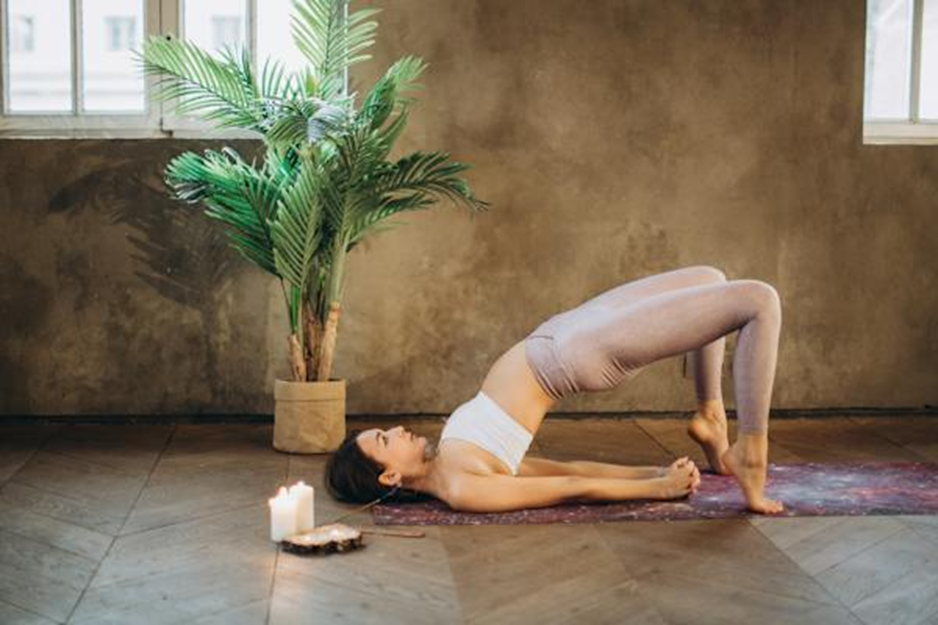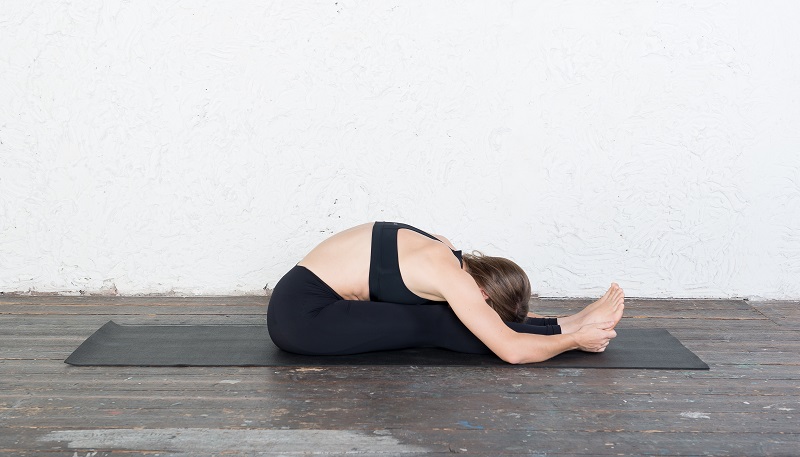A Step-By-Step Guide for Bridge Pose
Bridge Pose, also known as Setu Bandhasana in Sanskrit, is a dynamic posture that can be customized for different levels of expertise, making it appropriate for beginners while also providing chances for refinement for more experienced practitioners.

The bridge symbol of connection and passage in spiritual and philosophical settings throughout civilizations. Similarly, the bridge Pose reflects the idea of connecting many components of the self – body, mind, and spirit. In yoga philosophy, the spine is commonly regarded as the bridge between the earthly and spiritual realms.
Source: https://shivholisticyogaschool.wordpress.com/2023/12/29/a-step-by-step-guide-for-bridge-pose/
The benefit of Bridge Pose
- Back, glutes, and hamstrings are strengthened: Bridge Pose aggressively stimulates the muscles of the back, glutes, and hamstrings, which aids in the development of strength in these regions.
- Improves spinal mobility and flexibility: A mild stretch along the spine promotes flexibility and mobility in this position. Regular practice might help to make the spine more flexible and agile.
- Stability is achieved by engaging the core: Bridge Pose works the core muscles, particularly the abdominals. This involvement increases stability and helps to improve general core strength.
- Neck and shoulder tension is relieved: The position allows for a gradual expansion of the chest, which can assist in easing neck and shoulder stress. It mitigates the negative consequences of extended sitting and bad posture.
- Thyroid Gland Stimulant: Bridge Pose activates the thyroid gland, which is important in metabolic regulation. This can help with energy levels and a balanced metabolism.
- Promotes Energetic Flow: The posture promotes the passage of prana, or energy, throughout the body. This can boost vigor and give a sense of renewal.
- Improves Coordination and Balance: Bridge Pose, which involves balancing on the shoulders and activating the core, can help to improve general balance and coordination.
- Activates the Chest and Heart Center: Bridge Pose energetically lifts and opens the heart center, generating a sensation of expansion. This can result in an increase in emotional well-being and a sense of lightness.
Step-by-Step Guide for Bridge Pose
- Beginning position: Begin by lying on your back with your knees bent and your feet hip-width apart and parallel. Make sure your arms are parallel to your body, palms facing down.
- Foot Positioning: Firmly press your feet into the ground, grounding all four corners, including the inner and outer borders. Place your heels directly beneath your knees.
- Pelvic Elevation: Inhale and elevate your hips to the ceiling, engaging your core. Roll your spine off the mat, articulating through the spine, one vertebra at a time.
- Shoulder Participation: To widen your chest, slide your shoulder blades down your back. Maintain parallel arms with hands pointing down.
- Fingers interlaced: You can also interlace your fingers beneath your back and stretch your arms. Roll your shoulders under and raise your chest towards your chin if interlacing.
- Position of the Neck and Head: Avoid any tension by keeping your neck long and relaxed. The gaze might be directed towards the chest or above.
- Hold and inhale: Hold the stance for a few breaths, allowing your chest to expand and your front to open.
- Release: Exhale as you slide your spine back down to the mat, gently releasing your hands.
Variation and Modification for Bridge Pose
● Supported bridge pose: Place a yoga block beneath your sacrum for more support for a milder backbend.
● Bridge with One Leg: Lift one leg towards the ceiling while keeping the other foot on the ground in a solid bridge posture.
● Urdhva Dhanurasana (Wheel Pose): Explore the transition to Wheel Pose by straightening your arms for more experienced practitioners.
● Support for the Wall: Bridge Practice Pose with your feet against a wall for extra stability and knowledge of your alignment.
● The Dynamic Bridge: Include movement by raising and lowering your hips in a rhythmic pattern to improve the flow of the position.
● Hands-Free Alternative: Once you’re comfortable with the posture, try hands-free variants by letting your arms rest alongside your body.
Precaution and Contradictions in Bridge Pose
- Neck and spine problems: Individuals suffering from neck injuries or major spinal disorders should proceed with caution. Before trying Bridge Pose, contact a healthcare professional or an experienced yoga instructor.
- Recent Surgical Procedure: If you’ve recently had surgery, especially on your back, hips, or knees, avoid or modify Bridge Pose until you get permission from your doctor.
- Hypertension (high blood pressure): Backbends should be approached with caution by those with high blood pressure. To minimize severe strain, props or changes may be required.
- Injuries to the shoulder or wrist: Individuals with shoulder or wrist ailments should use caution when doing poses that need them to support their body weight on their hands, such as Bridge Pose. Consider making changes to reduce stress in these areas.
- Pregnancy: Pregnant women should contact their doctor before performing Bridge Pose, especially during the second and third trimesters. Modifications or other stances may be advised.
Important Tips for Bridge Pose
- Warm-Up: Perform a thorough warm-up sequence that includes mild stretches for the spine, hips, and shoulders before trying Bridge Pose. Sun Salutations and other pre-exercise positions can gradually raise body temperature and improve flexibility.
- Cooldown: After practicing Bridge Pose, take some time to calm down. Gentle stretches and relaxation postures, such as Child’s Pose or Supine Twist, can aid in the release of tension and the prevention of stiffness.
- Breath Control: Maintain mindfulness of your breath during the warm-up, position practice, and cool-down. Deep, deliberate breathing aids relaxation and prepares the body for the demands of the position.
- Hydration: Stay hydrated before and after your workout to improve overall health and muscular function.
Frequently Asked Questions about Bridge Pose
Is advanced flexibility required for Bridge Pose?
No, Bridge Pose may be modified to accommodate varying levels of flexibility. Modifications and changes make it suitable for practitioners of varied skill levels.
Can the Bridge Pose assist with lower back pain?
Bridge Pose helps alleviate minor lower back pain by strengthening the back muscles and increasing flexibility. Individuals suffering from chronic pain, on the other hand, should seek the advice of a healthcare practitioner before engaging in this practice.
What alterations may pregnant women make to Bridge Pose?
Pregnant women can practice Bridge Pose with adjustments, such as a lower lift or using props for support. However, before engaging in any yoga postures during pregnancy, it is critical to contact a healthcare expert.
How frequently should I perform Bridge Pose?
The frequency of practice is determined by the individual’s goals and level of comfort. Including Bridge Pose 2-3 times each week is a fantastic place to start.
Bottom line
As we end this article, we have concluded that Bridge Pose is a gateway to total well-being, not just a physical asana. If you have stayed with us till here then we invite you to embrace the Bridge Pose as a chance for self-discovery and thoughtful investigation.
You should approach this posture with openness and inquiry, whether you are a seasoned yogi or a beginner on your mat. We wish that your discovery of Bridge Pose be a joyful and fulfilling experience, helping you on your yoga path toward increased self-awareness, flexibility, and strength.
This was all! We hope you like reading this article! If you want to read more such ones then reach out to us on our website and delve deep into the world of yoga!
Stay safe and healthy!
Namaste!
Visit: yoga school in India | Yoga Teacher Training In India | 200 Hour Yoga Teacher Training in Rishikesh | 300 hour yoga Teacher Training In India | 500 hour yoga Teacher Training In India

